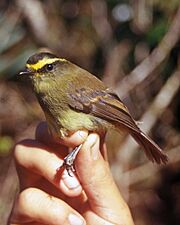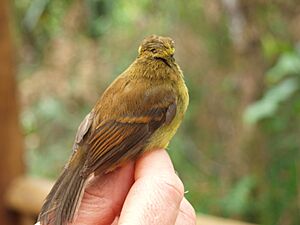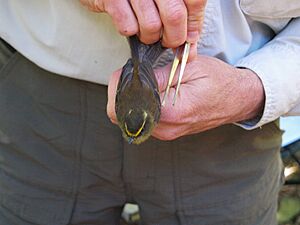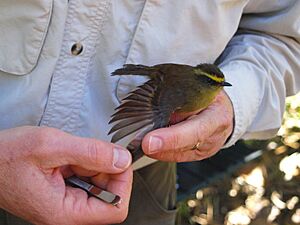Yellow-bellied chat-tyrant facts for kids
Quick facts for kids Yellow-bellied chat-tyrant |
|
|---|---|
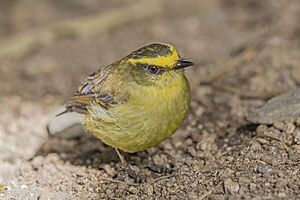 |
|
| Silvicultrix diadema gratiosa, Colombia | |
| Conservation status | |
| Scientific classification | |
| Genus: |
Silvicultrix
|
| Species: |
diadema
|
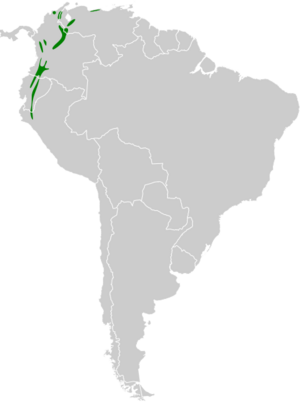 |
|
| Synonyms | |
|
|
The yellow-bellied chat-tyrant (Silvicultrix diadema) is a small bird that belongs to the passerine family. These birds are also known as "tyrant flycatchers." They are about 12 to 12.5 centimeters long. This bird looks a bit chunky and has a short, thin beak. Its body is mostly olive green. It has a yellow forehead and a long yellow stripe above its eye. Its wings and tail are dark, with two reddish-brown bars on the tail. You can find this bird mainly in Colombia, Ecuador, Peru, and Venezuela. It usually hunts for food in pairs, searching near the ground among leaves.
Contents
About the Yellow-bellied Chat-Tyrant
The yellow-bellied chat-tyrant is part of the bird group called Passeriformes. This group includes more than half of all bird species in the world! Within this large group, the yellow-bellied chat-tyrant belongs to the family Tyrannidae. This family is also known as the tyrant flycatchers. These birds live in North and South America. There are about 400 different species in this family. Most of them have plain colors like brown, gray, and yellow. They mostly eat insects. However, some might also eat berries or small bugs. Many species in this family catch insects by flying out from a perch and then returning.
What Does It Look Like?
The yellow-bellied chat-tyrant is a fairly small bird, measuring about 12.2 centimeters (about 4.8 inches) long. It has a dark olive-green body with a darker head. Its forehead is a yellowish-orange color, which continues as a thin stripe above its eyes. The area around its eyes is blackish. Its wings and tail are grayish-brown. The bird's belly and the feathers under its tail are bright yellow. It also has two reddish-brown bars on its wings and reddish-brown edges on its wing feathers.
Where Do They Live?
These birds live in natural places like moist montane forests and cloud forests in tropical and subtropical areas. They are often found at heights between 1,900 and 2,300 meters (about 6,200 to 7,500 feet) above sea level. However, they can live anywhere from 1,700 to 3,100 meters (about 5,600 to 10,200 feet) high. They are considered uncommon to fairly common in these areas. They like to stay on brushy hillsides in the forests of Colombia, Ecuador, Peru, and Venezuela. Even though they are common, they are hard to spot because they hide in the thick plants of the mountain understory.
Behavior and Habits
How They Find Food
The yellow-bellied chat-tyrant is a quiet bird that tries to stay hidden. They usually sit alone, upright, about 0.5 to 5 meters (about 1.6 to 16 feet) above the ground. They prefer mossy areas under trees. When hunting insects, they often flick their tails up. They fly short distances into the leaves, making a snapping sound as they catch bugs. They also hop from small branches to the ground to find food. Sometimes they seem brave, but they usually stay out of sight in thick bushes. They might sometimes join mixed groups of birds, but they don't follow them for long.
What Sounds Do They Make?
In the morning, at dawn, this bird sings a fast, thin, and soft trill. It sounds like fingers running up a comb, going slightly higher in pitch. During the day, their song is a long, buzzing trill that dips in the middle and then rises at the end. There's also a longer version during the day that slowly goes up, then drops a little at the very end. They also have a "conflict" call. This call slowly rises, then immediately drops in a slow trill, repeating over and over with other sharp, bickering sounds. The bird also sings for a short time at dusk.
Reproduction
Yellow-bellied chat-tyrants usually breed from January to October in Colombia. In Ecuador, they breed from March to December. They do not move to different places during the year, which means they are "resident" birds. They build mossy, ball-shaped nests on banks. These nests usually hold four creamy white eggs.



